The cactus family (Cactaceae) is a fascinating world of bright flowers and spiny stems, ranging from tiny plants to the huge desert giants. All cactus are native to the Americas, with the exception of one species. Cacti are found from British Columbia to South America, sharing a few specialized characteristics that determine whether or not a plant is a cactus.
Nearly all cactus species have spines that protect the plant’s moist interior from grazing animals and humans. The spines’ other functions include shading the skin and insulating the plant in cold, dry weather.
All cacti have flowers. Generally, cactus flowers are short-lived and provide the primary characteristics that separate cacti from other succulents. Cacti flowers have at least 10 petals, with the sepals combined with the petals, and have numerous stamens surrounding a multi-lobed stigma.
Whether or not an individual cactus plant blooms depends on its age and the care it gets. Some cacti don’t bloom until they are more than 30 years old. Others won’t bloom, even if they are old enough, unless they get proper light conditions, watering and fertilization. This is especially true for potted cacti.
Cactus With Yellow Flowers
- California Barrel Cactus (Ferocactus cylindraceus)
- Golden Barrel Cactus (Echinocactus grusonii)
- Balloon Cactus (Parodia magnifica)/ Notocactus Magnificus)
- Prickly Pear Cactus (Opuntia humifusa)
- Powder Puff Pincushion (Mammillaria bocasana)
- Matucana weberbaueri (Matucana ssp)
- Leuchtenbergia (Leuchtenbergia ssp)
- Bishop’s Hat Cactus (Astrophytum myriostigma)
- Monk’s hood cactus (Astrophytum ornatum)
- Yellow Christmas Cactus (Schlumbergera ‘Gold charm’)
- Moon Cactus (Gymnocalycium mihanovichii)
- Parodia Cactus (Parodia ssp)
- Feather Cactus ( Mammillaria plumosa)
- Club Cholla Cactus (Corynopuntia ssp)
- Texas nipple cactus (Mammillaria prolifera)
- Teddy bear cholla cactus
California Barrel Cactus

Ferocactus cylindraceus is usually cylindrical or spherical, with some older specimens forming columns 2 metres (6.6 ft) in height. It is covered in long, plentiful spines, which are straight and red when new and become curved and gray as they age.
The cactus bears flowers that are maroon outside, and bright yellow inside, with red or yellow centers on the side that faces the sun. The fleshy, hollow fruits are yellow.
Golden Barrel Cactus

It’s called a barrel cactus because, as the name implies, they are almost perfectly round when juvenile. They are beautiful, with evenly-spaced rows of spines on their deeply ribbed lobes. As they grow, it’s not uncommon for them to stretch out, so they are more oval than circular.
They can produce flowers but usually won’t start doing that until they are at least 6 inches wide, which can take about 15 years. Blooms get to about two to three inches wide and grow near the top of the barrel for about two to six weeks in the spring or summer. The flowers are generally yellow in color.
Balloon Cactus

Notocactus Magnificus (Balloon Cactus) recently renamed as Parodia Magnifica is a spherical cactus, blue-green in color, with yellowish and golden colored spines. This cactus usually grows in clusters but may also be solitary, depending on environmental factors.
Some can get quite large over time, up to 12 inches in diameter or more, but most will grow up to around 6 inches in diameter. They produce lovely light yellow flowers during the spring and summer months.
Prickly Pear Cactus

Opuntia, commonly called prickly pear or pear cactus is an easy-to-care-for cactus, favored by desert dwellers and cool-weather gardeners alike. Its stems are divided into flat paddle-like segments that are approximately two to seven inches long with a blue tint.
The narrow spines are wedge-shaped and the flowers, which come into bloom in mid-summer, are a brilliant yellow. The flowers are followed by edible purple or red fruits called tunas.
Powder Puff Pincushion Cactus
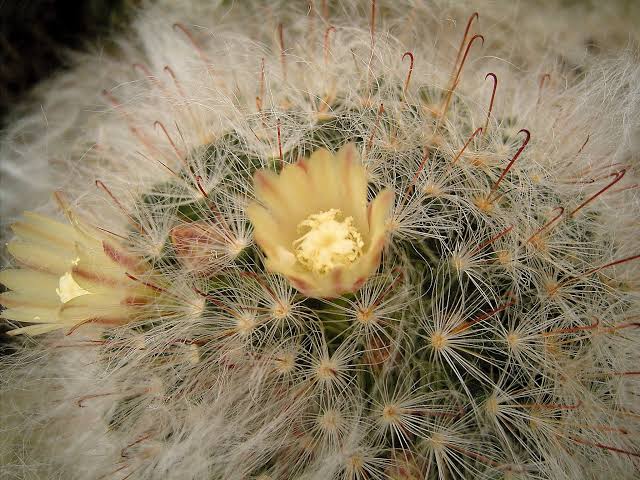
The Powder Puff Cactus is a small, hairy cactus found in North-Central Mexico. It is a globular cactus that sometimes gets cylindrical with age. It grows about 4 inches tall and has a round body covered in white, hair-like spines. The stem is grey-green, but this coloration is rarely visible underneath all the dense hair.
The spines are soft and silky, some longer than the others, covering the cactus’s body from every angle. Since this cactus has a clumping habit when mature, it looks like multiple cottony balls of fur clumped together. Mammilaria powder puffs will produce small whitish-yellow or yellow flowers depending on the cultivar grown.
Matucana weberbaueri

Matucana is a genus of cacti that are small, usually less than 12 inches tall, and mostly globular, although they often become more columnar as they age. They have tiny, flexible and widely spaced spines, which are sometimes slightly curved. Although the cacti are usually solitary, some may form clumps as they age.
The flowers are most often red, but can be pink, yellow or orange. They occur once the plants are 2 to 3 years old. The flowers appear at the apex of the plants (apical bloom) in the late spring and summer. They typically open at night and last from two to four days.
Leuchtenbergia
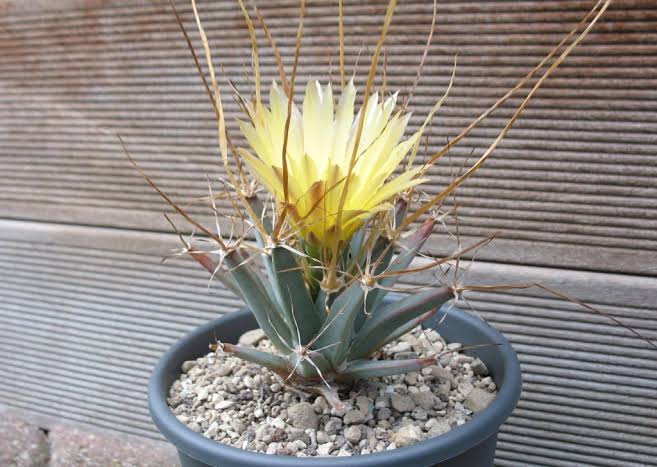
Leuchtenbergia (genus of cactus) is very slow-growing but can eventually grow up to 70 cm high, with a cylindrical stem which becomes bare and corky at the base with age. It has long, slender, grayish-green tubercles 6–12 cm long, with purplish-red blotches at their tips.
The tubercles are topped with papery spines, making the plant resemble an agave; old, basal tubercles dry up and fall off. After four years or so, yellow, funnel-shaped flowers 5–6 cm diameter may be borne at the tubercle tips.
Bishop’s cap cactus
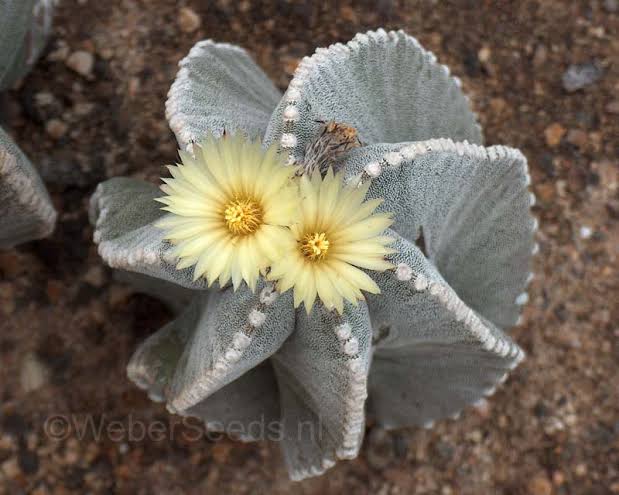
Its common name refers to its resemblance to a bishop’s miter, a cross-section of this cactus is almost startlingly reminiscent of one of these clergy hats. It usually reaches no more than 40 inches in height and up to 8 inches in diameter. It has four or five distinct ribs that increase to eight or more with age.
The plant is globose when young, becoming cylindroid as it gains more ribs. The gray-green flesh is covered with white flecks. The fragrant yellow flowers have numerous petals and usually appear in early spring or summer during the day.
Monk’s hood cactus
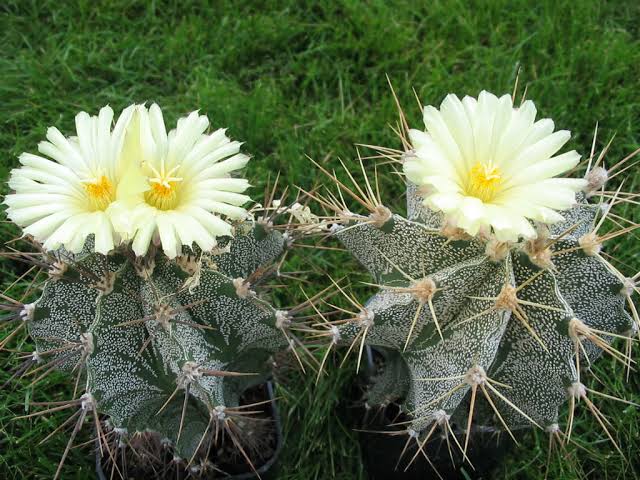
Monk’s hood has interesting geometric form from all angles. At the sides, it has a window pane effect of strong planes decorated with spines. Viewed from above it has a characteristic star shape, earning it the other name of star cactus, with 8 ribs making up the form. In its native habit, the cactus can grow more than 6 feet in height and a foot wide.
The greenish-gray skin develops white flecks which help protect the plant from searing sun. When young, it is a rounded plant becoming more columned as it matures. Monk’s hood cactus blooms in late spring. Flowers are creamy yellow, 2.5 inches wide, and have a lovely scent.
Schlumbergera “Gold Charm” or Yellow Christmas Cactus
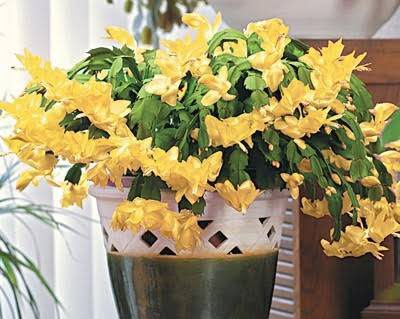
The Christmas cactus blooms from October through January, giving rise to its common name. It can produce yellow, pink, coral, fuchsia, white and bi-color blooms when grown under the right environment. Most species of Schlumbergera have stems which resemble leaf-like pads joined one to the other and flowers which appear from areoles at the joints and tips of the stems. Schlumbergera “Gold Charm” is a yellow variety that is a vigorous grower and features large, golden flowers.
Moon Cactus
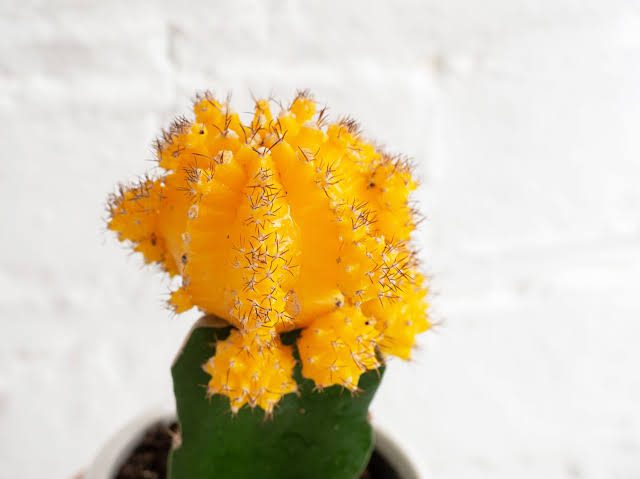
The individually growing Moon Cactus have a broad-spherical, gray-green, often reddish overgrown plant body, which reaches stature heights and diameter of 3 to 5 centimeters. The usually 8 ribs are narrow-edged and slightly notched.
The 5 to 6 weak, pliable, and slightly curved thorns are greyish-yellow, between 0.8 and 1 centimeter long and partly fall off. The 4 to 5 cm long, bell-shaped to funnel-shaped flowers are yellowish-olive to light olive green. The light green stamens are in two rows. The stylus is also light green; the scar yellowish.